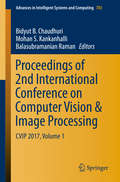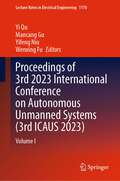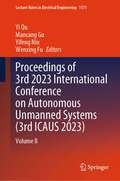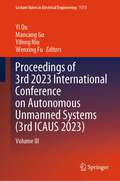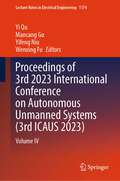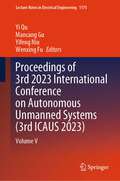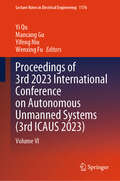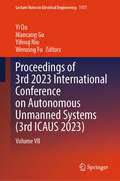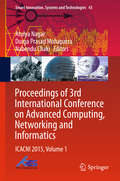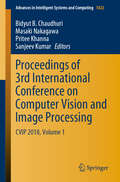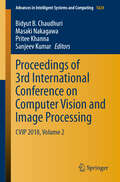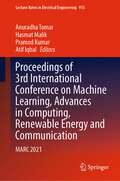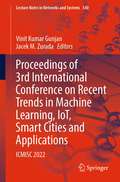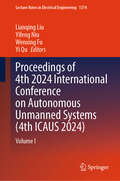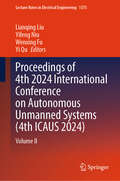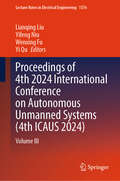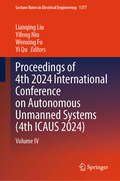- Table View
- List View
Proceedings of 2nd International Conference on Computer Vision & Image Processing: Cvip 2017, Volume 2 (Advances In Intelligent Systems And Computing #704)
by Mohan S. Kankanhalli Balasubramanian Raman Bidyut B. ChaudhuriThe book provides insights into the Second International Conference on Computer Vision & Image Processing (CVIP-2017) organized by Department of Computer Science and Engineering of Indian Institute of Technology Roorkee. The book presents technological progress and research outcomes in the area of image processing and computer vision. The topics covered in this book are image/video processing and analysis; image/video formation and display; image/video filtering, restoration, enhancement and super-resolution; image/video coding and transmission; image/video storage, retrieval and authentication; image/video quality; transform-based and multi-resolution image/video analysis; biological and perceptual models for image/video processing; machine learning in image/video analysis; probability and uncertainty handling for image/video processing; motion and tracking; segmentation and recognition; shape, structure and stereo.
Proceedings of 2nd International Conference on Mathematical Modeling and Computational Science: ICMMCS 2021 (Advances in Intelligent Systems and Computing #1422)
by Sheng-Lung Peng Souvik Pal Cheng-Kuan LinThe conference proceeding of ICMMCS 2021 presents most recent scientific and technological advances in the fields of engineering mathematics and computational science to strengthen the links in the scientific community. It is a collection of high-quality, peer-reviewed research papers presented at the Second International Conference on Mathematical Modeling and Computational Science (ICMMCS 2021), held online during October 29–30, 2021. The topics covered in the book are mathematical logic and foundations, numerical analysis, neural networks, fuzzy set theory, coding theory, higher algebra, number theory, graph theory and combinatory, computation in complex networks, calculus, differential educations and integration, application of soft computing, knowledge engineering, machine learning, artificial intelligence, big data and data analytics, high-performance computing, network and device security, Internet of Things (IoT).
Proceedings of 2nd International Conference on Smart Computing and Cyber Security: Strategic Foresight, Security Challenges and Innovation (SMARTCYBER 2021) (Lecture Notes in Networks and Systems #395)
by Prasant Kumar Pattnaik Mangal Sain Ahmed A. Al-AbsiThis book presents high-quality research papers presented at the Second International Conference on Smart Computing and Cyber Security: Strategic Foresight, Security Challenges and Innovation (SMARTCYBER 2021) held during June 16–17, 2021, in the Department of Smart Computing, Kyungdong University, Global Campus, South Korea. The book includes selected works from academics and industrial experts in the field of computer science, information technology, and electronics and telecommunication. The content addresses challenges of cyber security.
Proceedings of 3rd 2023 International Conference on Autonomous Unmanned Systems: Volume I (Lecture Notes in Electrical Engineering #1170)
by Yi Qu Mancang Gu Yifeng Niu Wenxing FuThis book includes original, peer-reviewed research papers from the 3rd ICAUS 2023, which provides a unique and engaging platform for scientists, engineers and practitioners from all over the world to present and share their most recent research results and innovative ideas. The 3rd ICAUS 2023 aims to stimulate researchers working in areas relevant to intelligent unmanned systems. Topics covered include but are not limited to: Unmanned Aerial/Ground/Surface/Underwater Systems, Robotic, Autonomous Control/Navigation and Positioning/ Architecture, Energy and Task Planning and Effectiveness Evaluation Technologies, Artificial Intelligence Algorithm/Bionic Technology and their Application in Unmanned Systems.The papers presented here share the latest findings in unmanned systems, robotics, automation, intelligent systems, control systems, integrated networks, modelling and simulation. This makes the book a valuable resource for researchers, engineers and students alike.
Proceedings of 3rd 2023 International Conference on Autonomous Unmanned Systems: Volume II (Lecture Notes in Electrical Engineering #1171)
by Yi Qu Mancang Gu Yifeng Niu Wenxing FuThis book includes original, peer-reviewed research papers from the 3rd ICAUS 2023, which provides a unique and engaging platform for scientists, engineers and practitioners from all over the world to present and share their most recent research results and innovative ideas. The 3rd ICAUS 2023 aims to stimulate researchers working in areas relevant to intelligent unmanned systems. Topics covered include but are not limited to: Unmanned Aerial/Ground/Surface/Underwater Systems, Robotic, Autonomous Control/Navigation and Positioning/ Architecture, Energy and Task Planning and Effectiveness Evaluation Technologies, Artificial Intelligence Algorithm/Bionic Technology and their Application in Unmanned Systems.The papers presented here share the latest findings in unmanned systems, robotics, automation, intelligent systems, control systems, integrated networks, modelling and simulation. This makes the book a valuable resource for researchers, engineers and students alike.
Proceedings of 3rd 2023 International Conference on Autonomous Unmanned Systems: Volume III (Lecture Notes in Electrical Engineering #1173)
by Yi Qu Mancang Gu Yifeng Niu Wenxing FuThis book includes original, peer-reviewed research papers from the 3rd ICAUS 2023, which provides a unique and engaging platform for scientists, engineers and practitioners from all over the world to present and share their most recent research results and innovative ideas. The 3rd ICAUS 2023 aims to stimulate researchers working in areas relevant to intelligent unmanned systems. Topics covered include but are not limited to: Unmanned Aerial/Ground/Surface/Underwater Systems, Robotic, Autonomous Control/Navigation and Positioning/ Architecture, Energy and Task Planning and Effectiveness Evaluation Technologies, Artificial Intelligence Algorithm/Bionic Technology and their Application in Unmanned Systems.The papers presented here share the latest findings in unmanned systems, robotics, automation, intelligent systems, control systems, integrated networks, modelling and simulation. This makes the book a valuable resource for researchers, engineers and students alike.
Proceedings of 3rd 2023 International Conference on Autonomous Unmanned Systems: Volume IV (Lecture Notes in Electrical Engineering #1174)
by Yi Qu Mancang Gu Yifeng Niu Wenxing FuThis book includes original, peer-reviewed research papers from the 3rd ICAUS 2023, which provides a unique and engaging platform for scientists, engineers and practitioners from all over the world to present and share their most recent research results and innovative ideas. The 3rd ICAUS 2023 aims to stimulate researchers working in areas relevant to intelligent unmanned systems. Topics covered include but are not limited to: Unmanned Aerial/Ground/Surface/Underwater Systems, Robotic, Autonomous Control/Navigation and Positioning/ Architecture, Energy and Task Planning and Effectiveness Evaluation Technologies, Artificial Intelligence Algorithm/Bionic Technology and their Application in Unmanned Systems.The papers presented here share the latest findings in unmanned systems, robotics, automation, intelligent systems, control systems, integrated networks, modelling and simulation. This makes the book a valuable resource for researchers, engineers and students alike.
Proceedings of 3rd 2023 International Conference on Autonomous Unmanned Systems: Volume V (Lecture Notes in Electrical Engineering #1175)
by Yi Qu Mancang Gu Yifeng Niu Wenxing FuThis book includes original, peer-reviewed research papers from the 3rd ICAUS 2023, which provides a unique and engaging platform for scientists, engineers and practitioners from all over the world to present and share their most recent research results and innovative ideas. The 3rd ICAUS 2023 aims to stimulate researchers working in areas relevant to intelligent unmanned systems. Topics covered include but are not limited to: Unmanned Aerial/Ground/Surface/Underwater Systems, Robotic, Autonomous Control/Navigation and Positioning/ Architecture, Energy and Task Planning and Effectiveness Evaluation Technologies, Artificial Intelligence Algorithm/Bionic Technology and their Application in Unmanned Systems.The papers presented here share the latest findings in unmanned systems, robotics, automation, intelligent systems, control systems, integrated networks, modelling and simulation. This makes the book a valuable resource for researchers, engineers and students alike.
Proceedings of 3rd 2023 International Conference on Autonomous Unmanned Systems: Volume VI (Lecture Notes in Electrical Engineering #1176)
by Yi Qu Mancang Gu Yifeng Niu Wenxing FuThis book includes original, peer-reviewed research papers from the 3rd ICAUS 2023, which provides a unique and engaging platform for scientists, engineers and practitioners from all over the world to present and share their most recent research results and innovative ideas. The 3rd ICAUS 2023 aims to stimulate researchers working in areas relevant to intelligent unmanned systems. Topics covered include but are not limited to: Unmanned Aerial/Ground/Surface/Underwater Systems, Robotic, Autonomous Control/Navigation and Positioning/ Architecture, Energy and Task Planning and Effectiveness Evaluation Technologies, Artificial Intelligence Algorithm/Bionic Technology and their Application in Unmanned Systems.The papers presented here share the latest findings in unmanned systems, robotics, automation, intelligent systems, control systems, integrated networks, modelling and simulation. This makes the book a valuable resource for researchers, engineers and students alike.
Proceedings of 3rd 2023 International Conference on Autonomous Unmanned Systems: Volume VII (Lecture Notes in Electrical Engineering #1177)
by Yi Qu Mancang Gu Yifeng Niu Wenxing FuThis book includes original, peer-reviewed research papers from the 3rd ICAUS 2023, which provides a unique and engaging platform for scientists, engineers and practitioners from all over the world to present and share their most recent research results and innovative ideas. The 3rd ICAUS 2023 aims to stimulate researchers working in areas relevant to intelligent unmanned systems. Topics covered include but are not limited to: Unmanned Aerial/Ground/Surface/Underwater Systems, Robotic, Autonomous Control/Navigation and Positioning/ Architecture, Energy and Task Planning and Effectiveness Evaluation Technologies, Artificial Intelligence Algorithm/Bionic Technology and their Application in Unmanned Systems.The papers presented here share the latest findings in unmanned systems, robotics, automation, intelligent systems, control systems, integrated networks, modelling and simulation. This makes the book a valuable resource for researchers, engineers and students alike.
Proceedings of 3rd International Conference on Advanced Computing, Networking and Informatics
by Nabendu Chaki Durga Prasad Mohapatra Atulya NagarAdvanced Computing, Networking and Informatics are three distinct and mutually exclusive disciplines of knowledge with no apparent sharing/overlap among them. However, their convergence is observed in many real world applications, including cyber-security, internet banking, healthcare, sensor networks, cognitive radio, pervasive computing amidst many others. This two volume proceedings explore the combined use of Advanced Computing and Informatics in the next generation wireless networks and security, signal and image processing, ontology and human-computer interfaces (HCI). The two volumes together include 132 scholarly articles, which have been accepted for presentation from over 550 submissions in the Third International Conference on Advanced Computing, Networking and Informatics, 2015, held in Bhubaneswar, India during June 23-25, 2015.
Proceedings of 3rd International Conference on Artificial Intelligence, Robotics, and Communication: ICAIRC 2023 (Lecture Notes in Electrical Engineering #1172)
by Sanjay Yadav Yogendra Arya Dimitrios A. Karras Noredine Gherabi Shailesh M. PandeyThis volume comprises the select proceedings of the 3rd International Conference on Artificial Intelligence, Robotics, and Communication (ICAIRC 2023). The content focuses on big data and cloud computing and the application of artificial intelligence, robotics and engineering, the Internet of Things, and sensor technology. Some of the topics covered include robot control, perception systems, dexterous manipulation, robot sensing, and data fusion, technology architecture of IoT, information analysis and processing of IoT, dynamic resource supply and consumption, IoT chips and sensors, industrial IoT, and Big Data, the architecture of Big Data, security and privacy of Big Data, management and operation of cloud computing, etc. This volume will be of interest to those working in academia and industry in the fields of computation, communication, and engineering.
Proceedings of 3rd International Conference on Artificial Intelligence: ICAIAA 2022 (Algorithms for Intelligent Systems)
by Marcin Paprzycki Mahesh Bundele Garima Mathur Ashish TripathiThis book gathers outstanding research papers presented in the 3rd International Conference on Artificial Intelligence: Advances and Application (ICAIAA 2022), held in Poornima College of Engineering, Jaipur, India, during April 23–24, 2022. This book covers research works carried out by various students such as bachelor, master and doctoral scholars, faculty and industry persons in the area of artificial intelligence, machine learning, deep learning applications in health care, agriculture, and business, security. It also covers research in core concepts of computer networks, intelligent system design and deployment, real-time systems, WSN, sensors and sensor nodes, SDN, NFV, etc.
Proceedings of 3rd International Conference on Computer Vision and Image Processing: CVIP 2018, Volume 1 (Advances in Intelligent Systems and Computing #1022)
by Sanjeev Kumar Bidyut B. Chaudhuri Masaki Nakagawa Pritee KhannaThis book is a collection of carefully selected works presented at the Third International Conference on Computer Vision & Image Processing (CVIP 2018). The conference was organized by the Department of Computer Science and Engineering of PDPM Indian Institute of Information Technology, Design & Manufacturing, Jabalpur, India during September 29–October 01, 2018. All the papers have been rigorously reviewed by the experts from the domain. This 2 volume proceedings include technical contributions in the areas of Image/Video Processing and Analysis; Image/Video Formation and Display; Image/Video Filtering, Restoration, Enhancement and Super-resolution; Image/Video Coding and Transmission; Image/Video Storage, Retrieval and Authentication; Image/Video Quality; Transform-based and Multi-resolution Image/Video Analysis; Biological and Perceptual Models for Image/Video Processing; Machine Learning in Image/Video Analysis; Probability and uncertainty handling for Image/Video Processing; and Motion and Tracking.
Proceedings of 3rd International Conference on Computer Vision and Image Processing: CVIP 2018, Volume 2 (Advances in Intelligent Systems and Computing #1024)
by Sanjeev Kumar Bidyut B. Chaudhuri Masaki Nakagawa Pritee KhannaThis book is a collection of carefully selected works presented at the Third International Conference on Computer Vision & Image Processing (CVIP 2018). The conference was organized by the Department of Computer Science and Engineering of PDPM Indian Institute of Information Technology, Design & Manufacturing, Jabalpur, India during September 29 - October 01, 2018. All the papers have been rigorously reviewed by the experts from the domain. This 2 volume proceedings include technical contributions in the areas of Image/Video Processing and Analysis; Image/Video Formation and Display; Image/Video Filtering, Restoration, Enhancement and Super-resolution; Image/Video Coding and Transmission; Image/Video Storage, Retrieval and Authentication; Image/Video Quality; Transform-based and Multi-resolution Image/Video Analysis; Biological and Perceptual Models for Image/Video Processing; Machine Learning in Image/Video Analysis; Probability and uncertainty handling for Image/Video Processing; and Motion and Tracking.
Proceedings of 3rd International Conference on Computing Informatics and Networks: ICCIN 2020 (Lecture Notes in Networks and Systems #167)
by Ajith Abraham Oscar Castillo Deepali VirmaniThis book is a collection of high-quality peer-reviewed research papers presented in the Third International Conference on Computing Informatics and Networks (ICCIN 2020) organized by the Department of Computer Science and Engineering (CSE), Bhagwan Parshuram Institute of Technology (BPIT), Delhi, India, during 29–30 July 2020. The book discusses a wide variety of industrial, engineering and scientific applications of the emerging techniques. Researchers from academic and industry present their original work and exchange ideas, information, techniques and applications in the field of artificial intelligence, expert systems, software engineering, networking, machine learning, natural language processing and high-performance computing.
Proceedings of 3rd International Conference on Machine Learning, Advances in Computing, Renewable Energy and Communication: MARC 2021 (Lecture Notes in Electrical Engineering #915)
by Pramod Kumar Atif Iqbal Hasmat Malik Anuradha TomarThis book gathers selected papers presented at International Conference on Machine Learning, Advances in Computing, Renewable Energy and Communication (MARC 2021), held in Krishna Engineering College, Ghaziabad, India, during 10 – 11 December, 2021. This book discusses key concepts, challenges and potential solutions in connection with established and emerging topics in advanced computing, renewable energy and network communications.
Proceedings of 3rd International Conference on Mathematical Modeling and Computational Science: ICMMCS 2023 (Advances in Intelligent Systems and Computing #1450)
by Sheng-Lung Peng Souvik Pal Noor Zaman Jhanjhi Fathi AmsaadThe volume is a collection of high-quality, peer-reviewed research papers presented at the Third International Conference on Mathematical Modeling and Computational Science (ICMMCS 2023), held during 24 – 25 February 2023 in hybrid mode. The topics covered in the book are mathematical logic and foundations, numerical analysis, neural networks, fuzzy set theory, coding theory, higher algebra, number theory, graph theory and combinatory, computation in complex networks, calculus, differential educations and integration, application of soft computing, knowledge engineering, machine learning, artificial intelligence, big data and data analytics, high performance computing, network and device security, Internet of Things (IoT).
Proceedings of 3rd International Conference on Recent Trends in Machine Learning, IoT, Smart Cities and Applications: ICMISC 2022 (Lecture Notes in Networks and Systems #540)
by Vinit Kumar Gunjan Jacek M. ZuradaThe book is a collection of best selected research papers presented at the International Conference on Recent Trends in Machine Learning, IoT, Smart Cities and Applications (ICMISC 2022) held during 28 – 29 March 2022 at CMR Institute of Technology, Hyderabad, Telangana, India. This book will contain the articles on current trends of machine learning, internet of things, and smart cities applications emphasizing on multi-disciplinary research in the area of artificial intelligence and cyber physical systems. The book is a great resource for scientists, research scholars and PG students to formulate their research ideas and find the future directions in these areas. Further, this book serves as a reference work to understand the latest technologies by practice engineers across the globe.
Proceedings of 3rd International Conference on Smart Computing and Cyber Security: Strategic Foresight, Security Challenges and Innovation (SMARTCYBER 2023) (Lecture Notes in Networks and Systems #914)
by Prasant Kumar Pattnaik Mangal Sain Ahmed A. Al-AbsiThis book presents high-quality research papers presented at the Third International Conference on Smart Computing and Cyber Security: Strategic Foresight, Security Challenges and Innovation (SMARTCYBER 2023) held during December 5–6, 2023, in the Department of Smart Computing, Kyungdong University, Global Campus, South Korea. The book includes selected works from academics and industrial experts in the fields of computer science, information technology, and electronics and telecommunication. The content addresses challenges of cyber security.
Proceedings of 3rd International Conference on the Industry 4.0 Model for Advanced Manufacturing: Amp 2018 (Lecture Notes In Mechanical Engineering)
by Jun Ni Vidosav D. Majstorovic Dragan DjurdjanovicThis book presents the proceedings of the 3rd International Conference on the Industry 4.0 Model for Advanced Manufacturing (AMP 2018), held in Belgrade, Serbia, on 5–7 June 2018, the latest in a series of high-level conferences that brings together experts from academia and industry to exchange knowledge, ideas, experiences, research findings, and information in the field of manufacturing. The book addresses a wide range of topics, including, for example, design of smart and intelligent products, developments in CAD/CAM technologies, rapid prototyping and reverse engineering, multistage manufacturing processes, manufacturing automation in the Industry 4.0 model, cloud-based products, and cyber-physical and reconfigurable manufacturing systems. By providing updates on key issues and recent advances in manufacturing engineering and technologies, it aids the transfer of vital knowledge to the next generation of academics and practitioners. It appeals to anyone working or conducting research in this rapidly evolving field.
Proceedings of 4th 2024 International Conference on Autonomous Unmanned Systems: Volume I (Lecture Notes in Electrical Engineering #1374)
by Lianqing Liu Yi Qu Yifeng Niu Wenxing FuThis book includes original, peer-reviewed research papers from the 4th ICAUS 2024, which provides a unique and engaging platform for scientists, engineers and practitioners from all over the world to present and share their most recent research results and innovative ideas. The 4th ICAUS 2024 aims to stimulate researchers working in areas relevant to intelligent unmanned systems. Topics covered include but are not limited to: Unmanned Aerial/Ground/Surface/Underwater Systems, Robotic, Autonomous Control/Navigation and Positioning/ Architecture, Energy and Task Planning and Effectiveness Evaluation Technologies, Artificial Intelligence Algorithm/Bionic Technology and their Application in Unmanned Systems. The papers presented here share the latest findings in unmanned systems, robotics, automation, intelligent systems, control systems, integrated networks, modelling and simulation. This makes the book a valuable resource for researchers, engineers and students alike.
Proceedings of 4th 2024 International Conference on Autonomous Unmanned Systems: Volume II (Lecture Notes in Electrical Engineering #1375)
by Lianqing Liu Yi Qu Yifeng Niu Wenxing FuThis book includes original, peer-reviewed research papers from the 4th ICAUS 2024, which provides a unique and engaging platform for scientists, engineers and practitioners from all over the world to present and share their most recent research results and innovative ideas. The 4th ICAUS 2024 aims to stimulate researchers working in areas relevant to intelligent unmanned systems. Topics covered include but are not limited to: Unmanned Aerial/Ground/Surface/Underwater Systems, Robotic, Autonomous Control/Navigation and Positioning/ Architecture, Energy and Task Planning and Effectiveness Evaluation Technologies, Artificial Intelligence Algorithm/Bionic Technology and their Application in Unmanned Systems. The papers presented here share the latest findings in unmanned systems, robotics, automation, intelligent systems, control systems, integrated networks, modelling and simulation. This makes the book a valuable resource for researchers, engineers and students alike.
Proceedings of 4th 2024 International Conference on Autonomous Unmanned Systems: Volume III (Lecture Notes in Electrical Engineering #1376)
by Lianqing Liu Yi Qu Yifeng Niu Wenxing FuThis book includes original, peer-reviewed research papers from the 4th ICAUS 2024, which provides a unique and engaging platform for scientists, engineers and practitioners from all over the world to present and share their most recent research results and innovative ideas. The 4th ICAUS 2024 aims to stimulate researchers working in areas relevant to intelligent unmanned systems. Topics covered include but are not limited to: Unmanned Aerial/Ground/Surface/Underwater Systems, Robotic, Autonomous Control/Navigation and Positioning/ Architecture, Energy and Task Planning and Effectiveness Evaluation Technologies, Artificial Intelligence Algorithm/Bionic Technology and their Application in Unmanned Systems. The papers presented here share the latest findings in unmanned systems, robotics, automation, intelligent systems, control systems, integrated networks, modelling and simulation. This makes the book a valuable resource for researchers, engineers and students alike.
Proceedings of 4th 2024 International Conference on Autonomous Unmanned Systems: Volume IV (Lecture Notes in Electrical Engineering #1377)
by Lianqing Liu Yi Qu Yifeng Niu Wenxing FuThis book includes original, peer-reviewed research papers from the 4th ICAUS 2024, which provides a unique and engaging platform for scientists, engineers and practitioners from all over the world to present and share their most recent research results and innovative ideas. The 4th ICAUS 2024 aims to stimulate researchers working in areas relevant to intelligent unmanned systems. Topics covered include but are not limited to: Unmanned Aerial/Ground/Surface/Underwater Systems, Robotic, Autonomous Control/Navigation and Positioning/ Architecture, Energy and Task Planning and Effectiveness Evaluation Technologies, Artificial Intelligence Algorithm/Bionic Technology and their Application in Unmanned Systems. The papers presented here share the latest findings in unmanned systems, robotics, automation, intelligent systems, control systems, integrated networks, modelling and simulation. This makes the book a valuable resource for researchers, engineers and students alike.
